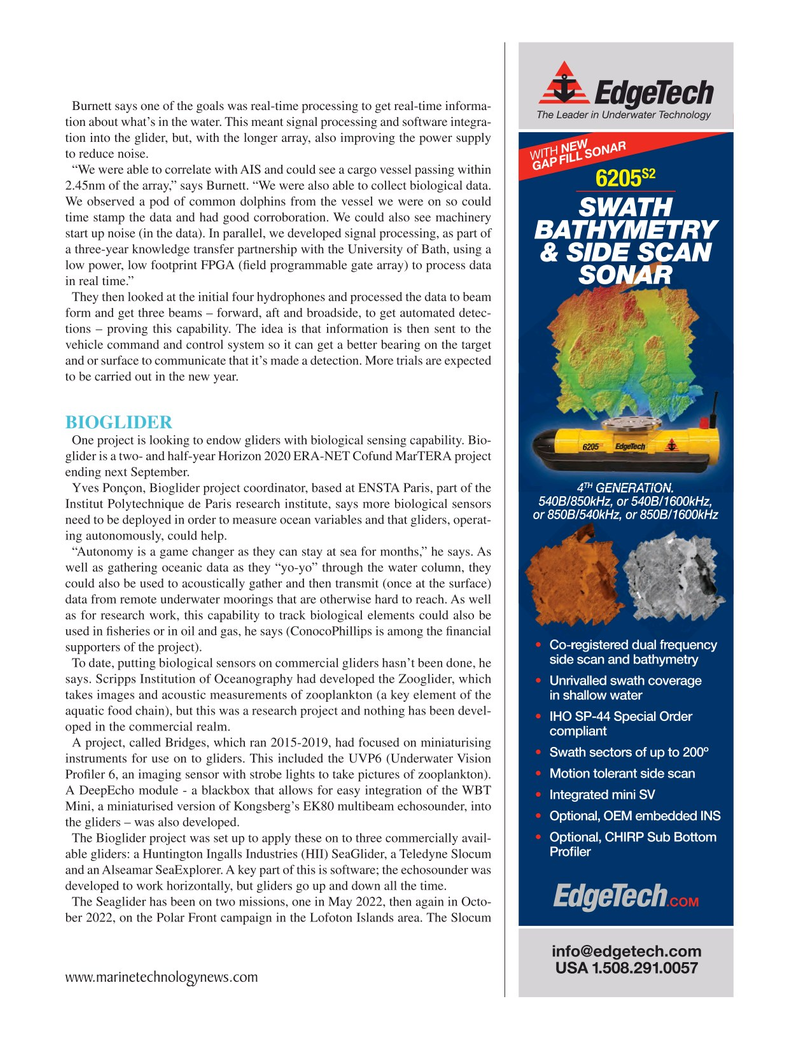
Page 31: of Marine Technology Magazine (November 2022)
Read this page in Pdf, Flash or Html5 edition of November 2022 Marine Technology Magazine
Burnett says one of the goals was real-time processing to get real-time informa- tion about what’s in the water. This meant signal processing and software integra- tion into the glider, but, with the longer array, also improving the power supply to reduce noise.
WITH NEW
GAP FILL SONAR “We were able to correlate with AIS and could see a cargo vessel passing within
S2 6205 2.45nm of the array,” says Burnett. “We were also able to collect biological data.
We observed a pod of common dolphins from the vessel we were on so could
SWATH time stamp the data and had good corroboration. We could also see machinery start up noise (in the data). In parallel, we developed signal processing, as part of
BATHYMETRY a three-year knowledge transfer partnership with the University of Bath, using a & SIDE SCAN low power, low footprint FPGA (? eld programmable gate array) to process data
SONAR in real time.”
They then looked at the initial four hydrophones and processed the data to beam form and get three beams – forward, aft and broadside, to get automated detec- tions – proving this capability. The idea is that information is then sent to the vehicle command and control system so it can get a better bearing on the target and or surface to communicate that it’s made a detection. More trials are expected to be carried out in the new year.
BIOGLIDER
One project is looking to endow gliders with biological sensing capability. Bio- glider is a two- and half-year Horizon 2020 ERA-NET Cofund MarTERA project ending next September.
TH
Yves Ponçon, Bioglider project coordinator, based at ENSTA Paris, part of the 4 GENERATION.
540B/850kHz, or 540B/1600kHz,
Institut Polytechnique de Paris research institute, says more biological sensors or 850B/540kHz, or 850B/1600kHz need to be deployed in order to measure ocean variables and that gliders, operat- ing autonomously, could help. “Autonomy is a game changer as they can stay at sea for months,” he says. As well as gathering oceanic data as they “yo-yo” through the water column, they could also be used to acoustically gather and then transmit (once at the surface) data from remote underwater moorings that are otherwise hard to reach. As well as for research work, this capability to track biological elements could also be used in ? sheries or in oil and gas, he says (ConocoPhillips is among the ? nancial • Co-registered dual frequency supporters of the project). side scan and bathymetry
To date, putting biological sensors on commercial gliders hasn’t been done, he says. Scripps Institution of Oceanography had developed the Zooglider, which • Unrivalled swath coverage takes images and acoustic measurements of zooplankton (a key element of the in shallow water aquatic food chain), but this was a research project and nothing has been devel- • IHO SP-44 Special Order oped in the commercial realm. compliant
A project, called Bridges, which ran 2015-2019, had focused on miniaturising • Swath sectors of up to 200º instruments for use on to gliders. This included the UVP6 (Underwater Vision
Pro? ler 6, an imaging sensor with strobe lights to take pictures of zooplankton). • Motion tolerant side scan
A DeepEcho module - a blackbox that allows for easy integration of the WBT • Integrated mini SV
Mini, a miniaturised version of Kongsberg’s EK80 multibeam echosounder, into • Optional, OEM embedded INS the gliders – was also developed.
The Bioglider project was set up to apply these on to three commercially avail- • Optional, CHIRP Sub Bottom 3URðOHU able gliders: a Huntington Ingalls Industries (HII) SeaGlider, a Teledyne Slocum and an Alseamar SeaExplorer. A key part of this is software; the echosounder was developed to work horizontally, but gliders go up and down all the time.
The Seaglider has been on two missions, one in May 2022, then again in Octo- ber 2022, on the Polar Front campaign in the Lofoton Islands area. The Slocum www.marinetechnologynews.com
MTR #8 (18-33).indd 31 11/28/2022 3:22:59 PM

 30
30

 32
32
